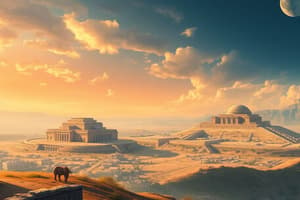Podcast
Questions and Answers
What was the primary reason for the construction of brick columns in ancient Uruk?
What was the primary reason for the construction of brick columns in ancient Uruk?
- To support the weight of the temple roof (correct)
- To showcase the skill of architects
- To honour the rulers
- To create a colourful mosaic
What was a significant technological advancement in ancient Uruk around 3000 BCE?
What was a significant technological advancement in ancient Uruk around 3000 BCE?
- The invention of the wheel
- The creation of clay cones
- The development of bronze tools (correct)
- The use of copper tools
What was the purpose of the clay cones in ancient Uruk?
What was the purpose of the clay cones in ancient Uruk?
- To decorate the temple walls
- To create a colourful mosaic
- To push into temple walls, creating a colourful mosaic (correct)
- To construct brick columns
What was a significant achievement in ancient Urukian sculpture?
What was a significant achievement in ancient Urukian sculpture?
What was the impact of the potter's wheel on urban economy?
What was the impact of the potter's wheel on urban economy?
What can be inferred about the social hierarchy in ancient Uruk?
What can be inferred about the social hierarchy in ancient Uruk?
What was the significance of the stele shown in the content?
What was the significance of the stele shown in the content?
What was the purpose of the cylinder seal shown in the content?
What was the purpose of the cylinder seal shown in the content?
What can be inferred about the craftsmen in ancient Uruk?
What can be inferred about the craftsmen in ancient Uruk?
What was the significance of the temple architecture in ancient Uruk?
What was the significance of the temple architecture in ancient Uruk?
Flashcards are hidden until you start studying
Study Notes
Accurate Carpentry and Bronze Tool Making
- A bronze tool maker does not go out to get metals (copper, tin, etc.) but needs regular supplies of charcoal for fuel.
- Division of labor is a mark of urban life, requiring organized trade, storage, and social organization.
Mesopotamian City Life
- City manufacturers needed fuel, metal, various stones, wood, etc., from many different places.
- Organized trade and storage were necessary, including deliveries of grain and other food items from villages to cities.
- Food supplies needed to be stored and distributed, and various activities had to be coordinated.
Mesopotamian Sculpture
- The Warka Head, a world-famous sculpture, was made of white marble at Uruk before 3000 BCE.
- The eyes and eyebrows would have taken lapis lazuli (blue), shell (white), and bitumen (black) inlays, respectively.
- The head was sculpted in a hard stone imported from a distance.
Movement of Goods into Cities
- Mesopotamia lacked stones for tools, seals, and jewels, and wood for carts, cart wheels, or boats.
- There was no metal for tools, vessels, or ornaments, leading to trade with regions like Turkey and Iran for materials like wood, copper, tin, silver, gold, shell, and various stones.
- Regular exchanges were initiated by the people of southern Mesopotamia, requiring social organization.
Urban Development
- Efficient transport is crucial for urban development, as slow or costly transportation of goods like grain or charcoal can make the city economy unviable.
- Rulers commanded people to fetch stones or metal ores, make bricks, or lay bricks for temples, and initiated technical advances at Uruk around 3000 BCE.
- Bronze tools were used for various crafts, and architects learned to construct brick columns due to a lack of suitable wood.
Technological Advances
- Hundreds of people worked on making and baking clay cones for temple walls, creating colorful mosaics.
- Sculpture achievements were made in imported stone, and the potter's wheel enabled mass production of pots.
The Seal – An Urban Artefact
- Steles are stone slabs with inscriptions or carvings.
- Cylinder seals feature intricate designs, like the one showing a bearded and armed standing figure, similar to the hero in the stele.
Studying That Suits You
Use AI to generate personalized quizzes and flashcards to suit your learning preferences.




